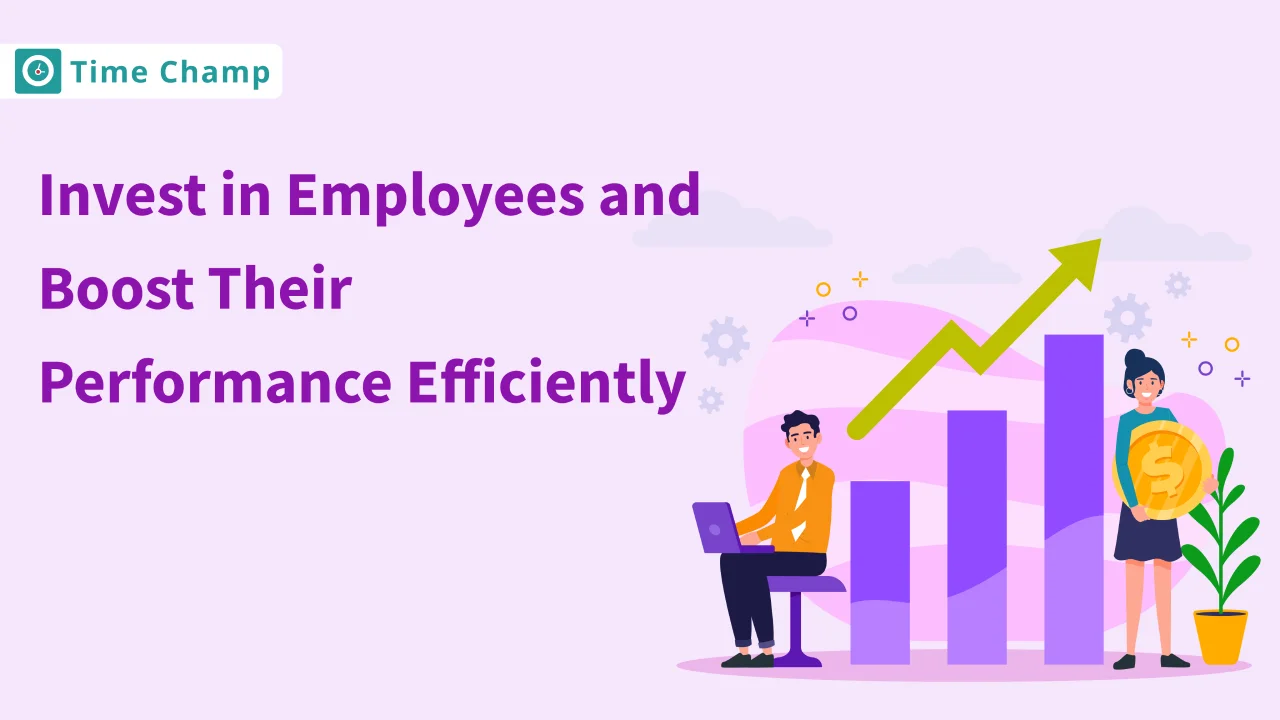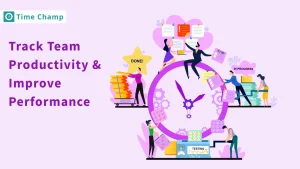Why do you invest so much in the furniture and systems in the office, to make your employees physically comfortable right? Then what about your employee’s mental and skill growth that helps them to work efficiently?
The best thing you can do is to invest in employees. Because employees are the only valuable asset that a company has.
Employees today no longer view training as a perk but as an expectation. According to LinkedIn’s 2018 Workforce Learning Report, an impressive 94% of employees stated they would remain with a company for a longer duration if it actively supported their career growth.
A study by the Association for Talent Development (ATD) revealed that companies investing in formalized training saw a 24% higher profit margin compared to those that didn’t. Training led to increased productivity, employee engagement, and retention.
In this blog post let’s discuss the importance, need and the best ways to effectively invest in employees.
What do You Mean by Investing in Employees
Investing in employees means dedicating resources, such as time, money, and effort, to help them grow personally and professionally within a company. It entails offering the employees training, developmental opportunities, and support structures that enable the workers to improve their skills, knowledge, and capabilities.
You can invest in employees in various forms, including offering educational programs, mentoring, providing feedback, promoting work-life balance, and creating a positive work environment. Fundamentally, employee development is focused on creating a highly motivated, involved and productive workforce that, in the end, will be beneficial to the employees and the organization at large.
Most business owners’ first approach will be to cut unnecessary costs but investing in your employees pays off. This is because employees usually get loyal to the company which is the one that takes care of them the most. As a result, you can witness a drift in employee efficiency and productivity and the employees tend to stay longer with the organization.
Benefits of Investing in Employees
There are many benefits of investing in them, let’s discuss some of them.
Enhanced Skills: You can invest in employees by providing training and development opportunities, employees can acquire new skills and improve existing ones, making them more versatile and capable in their roles.
Increased Productivity: When employees feel valued and supported, they are more motivated to perform their best, resulting in higher levels of productivity and efficiency in the workplace.
Improved Morale: Invest in employees to foster a positive work environment where employees feel appreciated and respected. This boosts morale and creates a sense of loyalty and commitment to the organization.
Reduced Turnover: Employees who receive investment and support from their employer are more likely to stay with the company for the long term, reducing turnover rates and the associated costs of hiring and training new staff.
Innovation and Creativity: Investing in employee development encourages innovation and creativity as employees feel empowered to contribute their ideas and take on new challenges.
Better Customer Service: Employees who are well-trained and engaged are better equipped to provide excellent customer service, leading to increased customer satisfaction and loyalty.
Competitive Advantage: A workforce that is continuously learning and growing gives the organization a competitive edge in the market, as they are better able to adapt to changes and meet evolving customer needs.
Stronger Team Dynamics: Invest in employees to foster a sense of team spirit and teamwork, leading to stronger relationships and collaboration among colleagues.
What are the Ways to Invest in Employees
Invest in your employees using these methods to boost your employee performance.
1. Training and Development Programs
Invest in employees by giving them a chance to improve their skills and knowledge by organizing training sessions, workshops, seminars, and online courses. This not only improves their capabilities but also boosts their confidence and job satisfaction.
2. Mentoring and Coaching
Invest in employees by pairing employees with mentors or coaches who have experience and can give them advice, guidance, and support as they progress in their careers. This helps them a lot in growing professionally and encourages continuous learning.
3. Performance Feedback and Recognition
Continuous feedback gives employees positive input on their performance, pointing out their strengths and areas for improvement. Additionally, recognize their achievements and contributions and reward them to show appreciation and motivation.
4. Work-Life Balance Support
Invest in employees by providing flexible work schedules like telecommuting or flexible hours to help employees with work-life balance. Encourage taking breaks, vacations, and mental health days to prevent burnout and promote well-being.
5. Health and Wellness Initiatives
Implement wellness programs and initiatives that focus on the physical, mental, and emotional well-being of employees. This can include providing access to gym facilities, offering healthy snacks, organizing mindfulness sessions, and providing resources for stress management.
6. Career Advancement Opportunities
Develop well-defined career pathways within the organization, such as promotions, lateral moves, and skill enhancement. Support employees in setting and achieving their career goals through personalized development plans and mentorship.
7. Transparent Communication
Invest in employees by promoting open and transparent communication channels where employees are free to express their concerns, give feedback, and share their ideas. Keep them informed about company updates, goals, and initiatives to cultivate a sense of belonging and alignment with the organization’s mission.
8. Employee Engagement Activities
Try organizing team-building events, social gatherings, and volunteer activities to foster staff relationships and create a positive working environment. Encourage collaboration, team spirit, and a sense of community within the workplace.
9. Introducing Reward Programs
Recognize and reward employees who have excelled or achieved goals ahead of schedule and contributed to the company’s success. These rewards may include bonuses, and salary increases, as well as expressing appreciation and acknowledgement for their efforts.
Let us suggest one more way that helps in investing in your employees and effectively provides insights into employee needs and requirements by tracking employee activities.
10. Using an Employee Productivity Tracking Tool
Using an employee monitoring tool like Time Champ, this tool provides insights into employee performance and productivity and also provides insights into employee tools and website usage. By examining this data, you can assess your employees’ needs and determine whether additional investments are necessary. This allows you to make informed decisions about where to allocate resources based on your employees’ requirements.
Some of the features Time Champ offers
1. Time Tracking and Resource Allocation
Track gain insights on how employees spend their time on different tasks and projects. By analyzing this data, managers can identify areas where employees may need additional training or support to improve efficiency and productivity.
It also allows for better resource allocation, ensuring that employees are assigned tasks that align with their skills and interests, thus maximizing their potential.
2. Performance Evaluation
This feature allows managers to accurately measure employee performance based on time spent on tasks, project completion rates, and overall productivity levels. This data-driven approach eliminates biases and provides objective criteria for evaluating employee contributions, making performance reviews fair and transparent.
Additionally, managers can identify top performers and reward them accordingly, fostering a culture of recognition and motivation.
3. Workflow Analysis
Managers can identify bottlenecks and inefficiencies in workflow processes. By analyzing time logs and task completion times, managers can pinpoint areas where tasks get delayed or stuck, allowing them to take proactive measures to address these issues.
This could involve redistributing workload, providing additional training, or implementing process improvements to streamline operations and maximizing productivity.
4. Project Management
Easily tracking project costs and employee hours, enabling managers to stay within budget constraints. By monitoring time spent on tasks and projects in real time, managers can make informed decisions about resource allocation and project timelines, ensuring that projects are completed on time and within budget.
This helps in optimizing resource utilization and maximizing the return on investment in employee time and effort.
5. Employee Tracking
By providing employees with visibility into their own time usage and productivity levels, Time Champ promotes accountability and self-awareness. Employees can track their progress, set goals, and identify areas for improvement, empowering them to take ownership of their work and performance.
This fosters a culture of accountability and continuous improvement, leading to higher levels of employee engagement and satisfaction.
Check out more features that may help you efficiently invest in your employees while maintaining a budget- Sign up
Ready to Improve Your Employee Productivity?
Monitor. Analyze. Act. Take Control over Your Employee Productivity
Signup for Free!Book DemoMistakes to Avoid while Investing in Employees
Knowing what to do is helpful when starting something new. But if you also know what not to do, you’re all set to achieve new things.
Try to avoid these mistakes while investing in your employees and you are good to go.
1. Neglecting Individual Needs: Avoid the mistake of assuming that all employees have the same development needs or aspirations.
Take the time to understand each employee’s unique strengths, weaknesses, career goals, and preferences. Tailor your investment efforts to meet individual needs and provide personalized development opportunities.
2. Lack of Clear Goals: Failing to establish smart goals and objectives for employee development initiatives can lead to confusion and inefficiency.
Clearly define the desired outcomes of your investment efforts and communicate them to employees. Set SMART (Specific, Measurable, Achievable, Relevant, Time-bound) goals to guide their development journey and track progress effectively.
3. Poor Feedback and Communication: Neglecting to provide regular feedback and keeping communication closed can stop employees from growing and getting involved.
Foster a culture of constructive feedback and transparent communication where employees feel comfortable sharing their concerns, seeking guidance, and providing input. Ensure that feedback is timely, specific, and actionable to support continuous improvement.
4. Overlooking Employee Input: Ignoring what employees have to say and what they like when creating training programs can make them feel disconnected and unwilling to participate.
Involve employees in the planning and decision-making process to ensure that development initiatives align with their interests, needs, and learning styles. Encourage active participation and collaboration to foster a sense of ownership and investment in their growth journey.
5. Ignoring Work-Life Balance: Overloading employees with training and development activities without considering their workload and personal commitments can backfire.
Respect employees’ time and boundaries by offering flexible scheduling options, prioritizing essential training, and avoiding excessive demands on their time. Promote a healthy work-life balance to prevent burnout and support overall well-being.
6. Lack of Accountability: Failing to hold employees and managers accountable for their roles in the development process can make it less effective.
Establish clear expectations, responsibilities, and accountability mechanisms for both employees and managers. Encourage ownership of development goals, regular progress assessments, and accountability for results to ensure that investment efforts yield meaningful outcomes.
7. Short-Term Focus: Thinking short-term and hoping for quick results from employee development efforts can cause disappointment and frustration.
Recognize that investing in employees is a long-term commitment that requires patience, persistence, and ongoing support. Focus on building a culture of continuous learning, growth, and improvement to reap lasting benefits for individuals and the organization.
Tips for Staying Updated with Changing Technology Trends
If you aim to keep your employees sharp and up-to-date with technology, it starts with you staying ahead of the curve. Here are some helpful tips to help you keep up with the latest changes in technology trends.
1. Follow Tech Blogs and Websites
Subscribe to reputable tech blogs, websites, and online forums that provide regular updates on the latest trends, innovations, and developments in the tech industry. Technology sites like TechCrunch, Wired, and The Verge provide insightful articles, product & start-up reviews, news updates, and technological analysis on emerging technology and industry trends.
2. Attend Tech Events and Conferences
Attend tech conferences, seminars, workshops, and industry events to network with professionals, gain firsthand knowledge about new technologies, and stay informed about current trends. Events such as CES, SXSW and TechCrunch Disrupt turn out to be precious moments for gaining information, networking and familiarizing with the most recent tech inventions.
3. Join Tech Communities and Groups
Join online tech communities, forums, and social media groups where professionals and enthusiasts share insights, discuss trends, and exchange ideas. Through social media platforms like Reddit, LinkedIn groups, and topic-specific forums there is a chance to interact with people who share your views, ask inevitable questions and keep up with the latest developments.
4. Engage in Continuous Learning
Commit to lifelong learning by taking online courses, attending workshops, and pursuing certifications in areas relevant to your interests and career goals. Some study platforms such as Coursera, Udemy and edX provide a large number of courses in subjects like artificial intelligence, cybersecurity, data science, and blockchain technology. Some study platforms such as Coursera, Udemy, edX and DataCamp provide a large number of courses in subjects like artificial intelligence, cybersecurity, data science, R programming courses and blockchain technology.
5. Follow Industry Experts and Influencers
Follow industry experts, influencers, and experts on social media platforms like Twitter, LinkedIn, and YouTube to access their insights, analyses, and predictions about technology trends. Interact with them, join their discussions, and acquire their knowledge to be up-to-date and optimistic.
6. Experiment with Emerging Technologies
Stay hands-on with emerging technologies by experimenting with new tools, software, and gadgets. Allot some time to familiarize yourself with beta versions, and new apps, and explore the horizon of technologies like virtual reality, augmented reality and IoT gadgets.
7. Read Industry Reports and Whitepapers
Keep up-to-date on industry reports, market research, and whitepapers published by reputable organizations, research firms, and technology companies. These reports provide observations that are directly applicable such as data, trends and analysis of the current and future technology shapes, the dynamics of the market and patterns of the consumer.
8. Network with Peers and Industry Professionals
Build and maintain relationships with peers, mentors, and industry professionals who can offer valuable insights, advice, and connections related to technology trends. Participate in networking events, be a member of a professional association, as well as take your time to talk to important people to enhance your knowledge and enable you to track the development in this industry.
Wrapping Up
Investing in your employees will be a life-changing decision if invested correctly by following the needs and requirements of the employees instead of just splurging on them.
By investing in employee skill enhancement and organizing team-building exercises, businesses can see a rise in productivity and efficiency, along with a decrease in stress levels among their workforce.
Make good use of the tips provided above in implementing employee investment strategies and thrive in today’s dynamic workplace.
Try it out for yourself- Book a free demo now
Also Read
A Guide to Employee Monitoring and Time Tracking Software Solutions
Top 5 Factors Affecting Productivity in Work Environment
Top Strategies to Improve Work Efficiency in Modern Workplaces
Investing in employees involves dedicating resources such as training, development programs, and support systems to help them grow personally and professionally within the company.
Investing in employees leads to higher job satisfaction, improved skills and productivity, and increased loyalty to the company, ultimately resulting in better overall performance.
Examples include providing training and development opportunities, offering mentorship programs, promoting work-life balance, and recognizing employee achievements.
Assess your employees’ needs through performance evaluations, surveys, and feedback sessions to identify areas for improvement and tailor investment strategies accordingly.
Benefits include improved employee retention, enhanced company culture, increased innovation, and ultimately, greater profitability and success.
Monitor key performance indicators such as employee engagement, retention rates, productivity levels, and feedback from employees to gauge the impact of your investment efforts.
Start with small, cost-effective initiatives such as cross-training programs, informal mentorship opportunities, or flexible work arrangements to begin investing in employees without straining resources.
Encourage a growth mindset, provide regular feedback, recognize and reward learning achievements, and lead by example by investing in your own professional development.








